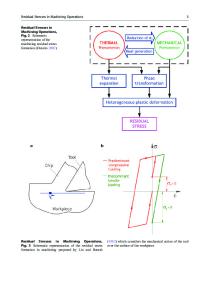An energy-based nanoindentation method to assess localized residual stresses and mechanical properties on shot-peened ma
- PDF / 608,869 Bytes
- 9 Pages / 584.957 x 782.986 pts Page_size
- 93 Downloads / 808 Views
An energy-based nanoindentation method to assess localized residual stresses and mechanical properties on shot-peened materials Siavash Ghanbari1 David F. Bahr1,a) 1
School of Materials Engineering, Purdue University, West Lafayette, Indiana 47906, USA Address all correspondence to this author. e-mail: [email protected]
a)
Received: 31 October 2018; accepted: 22 January 2019
Concurrently assessing localized residual stresses and mechanical properties in cases where there are gradients in stresses and properties (such as those resulting in metallic alloys from shot peening processes) is challenging. Most indentation-based stress measurements assume uniform properties, which is not necessarily the case in this common industrial process. By using the energy envelope describing the total work of indentation by a load–displacement curve from instrumented indentation, localized residual stresses after shot peening were evaluated experimentally. A framework is developed to describe the appropriate indentation depth at which to assess properties that effectively define the volumetric resolution of the method. The residual stresses predicted via the nanoindentation experiment and energy analysis were validated with X-ray measurement of residual stresses on a shot-peened 52100 steel. The energy method can be applied directly from the indentation load–displacement curve without considering the contact area.
Introduction Determination of localized residual stresses in metallic specimens is important in predicting fatigue lifetime after shot peening. The impact of the peening process on the material’s performance is highly dependent on the compressive residual stresses and strain hardening. Excessive residual stresses after peening process can have a destructive influence, and they can reduce the fatigue lifetime substantially [1]. Residual stresses can currently be measured experimentally using X-ray diffraction-based techniques, hole-drilling, and layer removal [2, 3], but these techniques are limited to millimeter-scale resolution in lateral dimensions, making relationships to grain-level materials structure challenging and limiting the ability to correlate with crystal plasticity models. Commercially available depth-sensing indentation techniques (commonly called nanoindentation) are able to measure hardness (proportional to flow strength), elastic modulus, and other mechanical properties on the micrometer scale, and several techniques have been developed to concurrently assess residual stresses by nanoindentation [4, 5]. Nanoindentation relies on interpreting the load–depth record during the penetration of a tip into a sample. Residual
ª Materials Research Society 2019
stresses can change load–depth curves by altering the amount of material in the “pileup” around the indenter probe, subsequently changing the real contact area relative to the depth of penetration [4, 6]. At a given penetration depth, the load–depth curve for a sample with a biaxial compressive residual stress is steeper than the stress-free sample and s
Data Loading...











